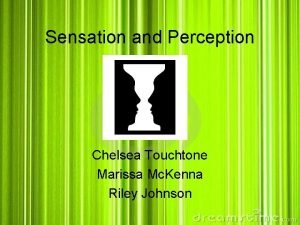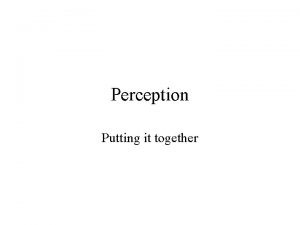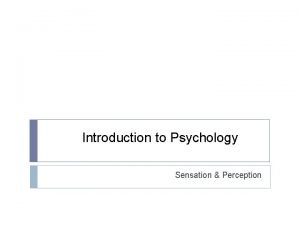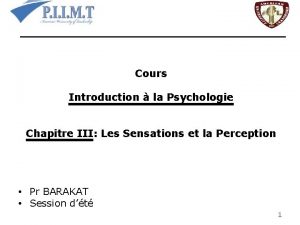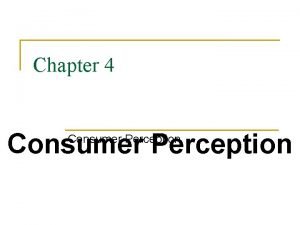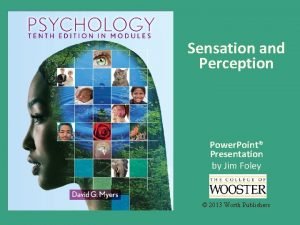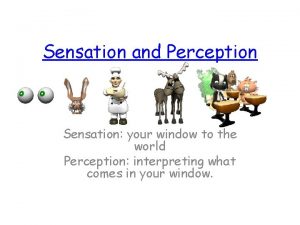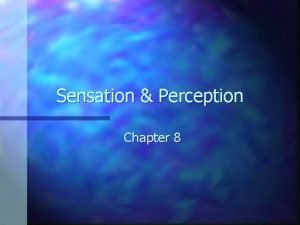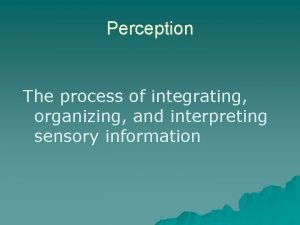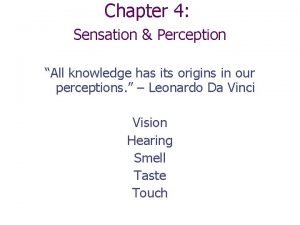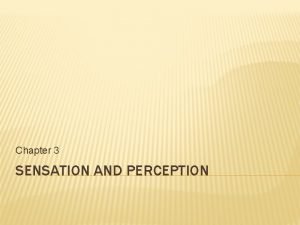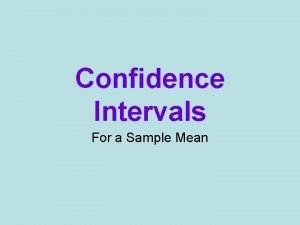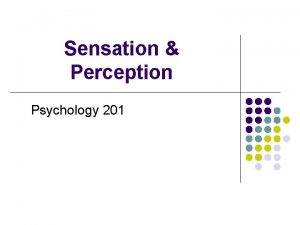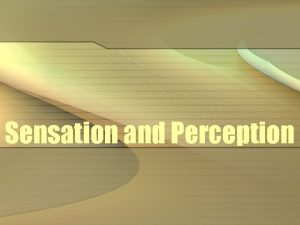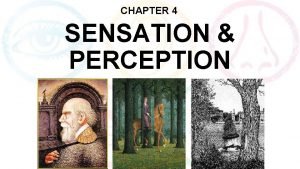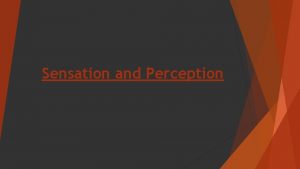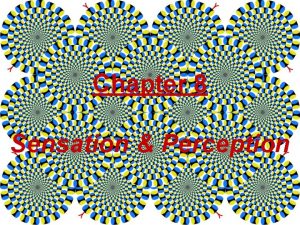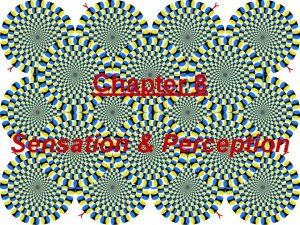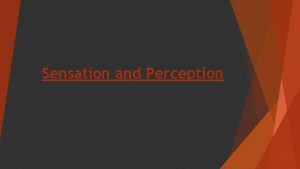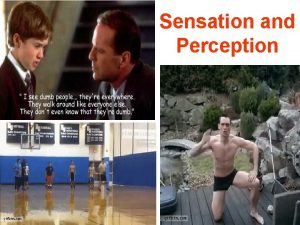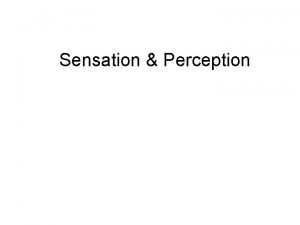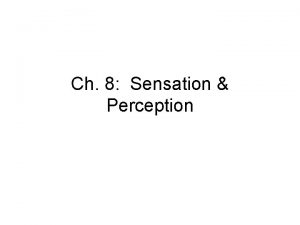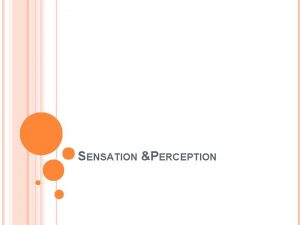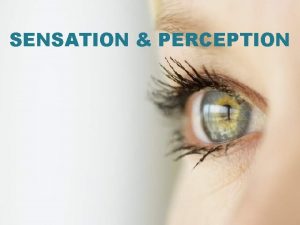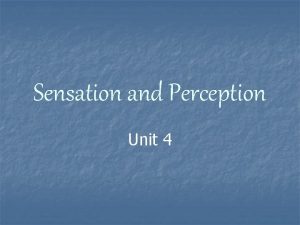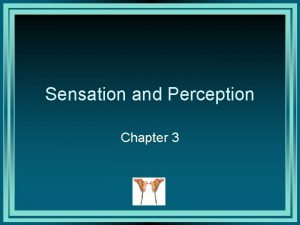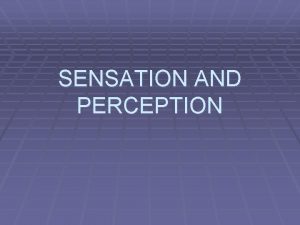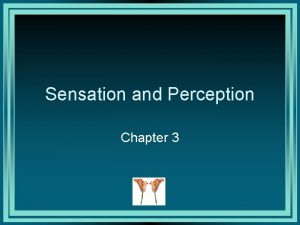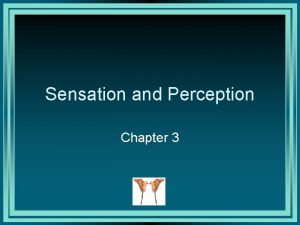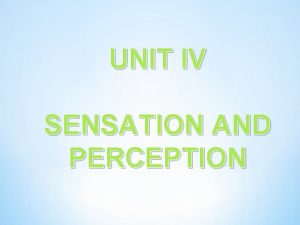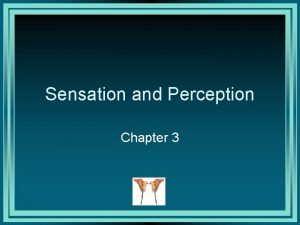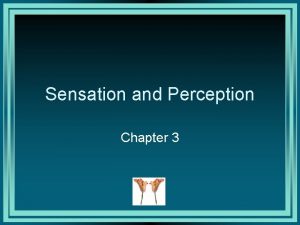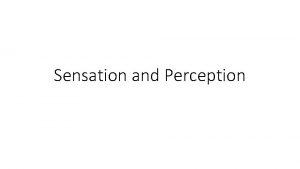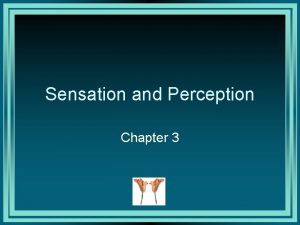WHS AP Psychology Sensation Perception Essential Task 4

























- Slides: 25

WHS AP Psychology Sensation, Perception Essential Task 4 -1: Discuss basic principles of sensation/bottom up processing with specific attention to sensory transduction, absolute threshold, difference threshold (Weber's Law), signal detection, and sensory adaptation.

Gestalt Principles Perceptual Constancies Basic Principles Visual Illusions Depth Perception Sensation Vision Theories The Eye Pain Other Senses Taste We are here Hearing The Ear Smell Theories

Sensation & Perception Outline How do we construct our representations of the external world? To represent the world, we must detect physical energy (a stimulus) from the environment and convert it into neural signals. This is a process called sensation. When we give meaning by selecting, organizing, and interpreting our sensations, the process is called perception.

Sensation vs. Perception Outline • Sensation – The experience of sensory stimulation • Perception – The process of creating meaningful patterns from raw sensory information

What do you see vs. what do you perceive? Outline

What do you see vs. what do you perceive? Outline

What do you see vs. what do you perceive? Outline

What do you see vs. what do you perceive? Outline

Bottom Up vs. Top Down Processing Outline Perception Sensati on

Bottom-up Processing Outline Analysis of the stimulus begins with the sense receptors and works up to the level of the brain and mind. Letter “A” is really a black blotch broken down into features by the brain that we perceive as an “A. ”

Top-Down Processing Outline Information processing is guided by higher-level mental processes as we construct perceptions, drawing on our experience and expectations. THE CHT

Example of Top-Down Processing Outline • Aoccdrnig to rscheearch at Cmabrigde Uinervtisy, it deosn't mttaer in waht oredr the ltteers in a wrod are, the olny iprmoetnt tihng is taht the frist and lsat ltteer be at the rghit pclae. The rset can be a total mses and you can sitll raed it wouthit a porbelm. Tihs is bcuseae the huamn mnid deos not raed ervey lteter by istlef, but the wrod as a wlohe.

SENSORY and SPECIES • Every species comes equipped with sensitivities that enable it to survive and thrive • Ex. Male silkworm moth (p. 194)

Absolute Threshold Outline • Smallest detectable LEVEL of a stimulus.

Detection must be 50% of time. Outline Absolute Threshold Intensity No No No Yes Observer’s Response Detected Tell when you (the observer) detect the light.

Absolute Thresholds Examples Outline • Taste: 1 gram (. 0356 ounce) of table salt in 500 liters (529 quarts) of water • Smell: 1 drop of perfume diffused throughout a three-room apartment • Touch: the wing of a bee falling on your cheek from a height of 1 cm (. 39 inch) • Hearing: the tick of a watch from 6 meters (20 feet) in very quiet conditions • Vision: a candle flame seen from 50 km (30 miles) on a clear, dark night

Signal Detection Theory • Why do absolute thresholds vary? Differences in babies cry • Why do people respond differently to the same stimuli?

Signal Detection Theory (SDT) Outline Predicts how and when we detect the presence of a faint stimulus (signal) amid background noise (other stimulation). SDT assumes that there is no single absolute threshold and detection depends on: Person’s experience Expectations Motivation Level of fatigue

SUBLIMINAL STIMULATION • We can unconsciously process information without being aware of it (below the absolute threshold) - experiment with “drink coca cola” - rock lyrics with “satanic messages” - Lose weight/stop smoking tapes • Subliminal messages…do they work?

DIFFERENCE THRESHOLD Outline - The smallest detectable CHANGE in a stimulus – Also called the just noticeable difference (jnd)

Difference Threshold Outline Difference Threshold: Minimum difference between two stimuli required for detection 50% of the time, also called just noticeable difference (JND). Difference Threshold No No Yes Observer’s Response Tell when you (observer) detect a difference in the light.

Weber’s Law Outline Two stimuli must differ by a constant minimum percentage (rather than a constant amount), to be perceived as different. Weber fraction: k = d. I/I. Light Constant (k) 8% Weight 2% Tone 3% Stimulus

Our perceptions are organized by meanings that our minds impose. Outline We perceive the world not as it is, but as it is useful for us.

Sensory adaptation Outline – An adjustment of the senses to the level of stimulation they are receiving Our sensitivity diminishes to constant and routine odors, sounds and touches Important because it focuses our attention on changes in stimulation rather than on everything! – Ever forgotten you are wearing a watch? – Ever gotten used to a smell?

Outline
 Copyright ?
Copyright ? Chapter 5 sensation and perception
Chapter 5 sensation and perception Gestalt principles of sensation and perception
Gestalt principles of sensation and perception Relative height ap psychology
Relative height ap psychology What are sensations
What are sensations Sensation & perception crossword review
Sensation & perception crossword review Chapter 3 sensation and perception
Chapter 3 sensation and perception Perceptual system
Perceptual system Sensation and perception
Sensation and perception Sensation et perception en psychologie
Sensation et perception en psychologie Chapter 6 sensation and perception
Chapter 6 sensation and perception Pecetion
Pecetion Perception vs sensation
Perception vs sensation Sensation and perception
Sensation and perception Opponent process theory
Opponent process theory Five basic taste sensations
Five basic taste sensations Old woman young woman illusion
Old woman young woman illusion Chapter 8 sensation and perception
Chapter 8 sensation and perception Sensation and perception uu
Sensation and perception uu Chapter 4 sensation and perception
Chapter 4 sensation and perception Chapter 3 sensation and perception
Chapter 3 sensation and perception Wwusd
Wwusd Confidence interval assumptions
Confidence interval assumptions Model whs act
Model whs act Safe work method statement definition
Safe work method statement definition Study whs
Study whs





